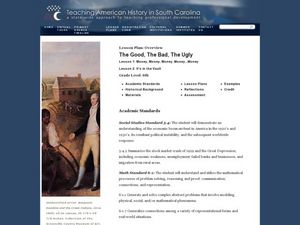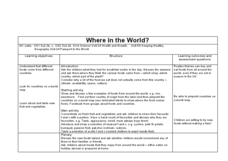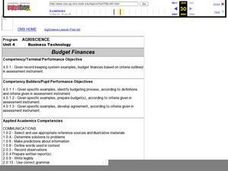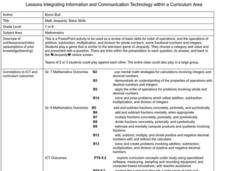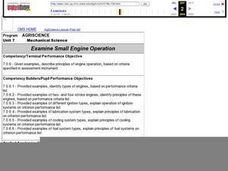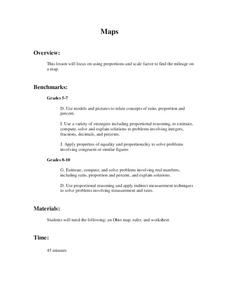Curated OER
Math: Currency Exchange Rates
Sixth graders apply the division and multiplication of decimals to convert dollars to various international currencies. In a travel simulation activity, they convert money, distance, and temperatures. During their "trip," students...
Curated OER
The Good, The Bad, The Ugly
Sixth graders examine the causes of the stock market crash of 1929. In this integrated math/history unit on the stock market, 6th graders study, research, and read stocks, visit a local bank, and create a PowerPoint to show the finished...
Curated OER
Making Change
Second graders explore how to incorporate a new type of technology, the cash register and/or a calculator, as a motivational tool for solving real life problems. They practice estimating money and counting back change from $20.00.
Curated OER
Barge Building: What Floats Your Boat?
Learners construct aluminum foil boats that float while holding the greatest number of pennies. They investigate the concept of water displacement, record their results, and watch a Bill Nye video on buoyancy.
Curated OER
Jazz and Math: Rhythmic Innovations
High schoolers compare and contrast the rhythms of marches and jazz. They watch an excerpt about Buddy Bolden from the PBS Ken Burns Jazz documentary, compare/contrast march and jazz rhythms, complete a worksheet, and notate and perform...
Mathematics TEKS Toolkit
Grade 6: Exploring c/d = pi
Introduce your math class to the perimeter of a circle. Teach them that pi describes the relationship between the circumference and the diameter. As a hands-on investigation, pairs or small groups use string to compare these two values...
Curated OER
Length Lotto-Teacher's Notes
Students convert metric units of length, specifically meters, centimeters, and millimeters. In this lesson of converting measurements, students participate in various games which require them to put the measurements in order or convert...
Curated OER
Where in the World
Students explore the global grid system. In this globe lesson, students identify latitude and longitude lines and how these can tell the coordinates of any place. They use the Internet to find the exact coordinates for their town.
Curated OER
Deric's Blotto
Students solve the handshake problem and investigate triangular numbers. In this geometry lesson, students investigate Blotto games as they apply concepts of triangles and geometric theorems.
Curated OER
Mountain Math Worksheet
In this number sense instructional activity, 5th graders solve 37 problems based on a given number. Students are asked to round the number, identify the number as even or odd and add 100 to the number.
Curated OER
Goobers. Goobers? Goobers!
Students begin the activity by noting the many ways in which to use peanuts. In groups, they use the internet to research the work of George Washington Carver. They discover the allergies and nutritional information of the peanut and...
Curated OER
Let's Take a Trip!
Sixth graders plan trip for family of four, and choose best travel plan by studying maps, considering different routes, and visiting Web sites to get airline and travel schedules.
Curated OER
Circumference of a Pumpkin
Fourth graders watch a video and find the circumference of a pumpkin. In this circumference lesson, 4th graders watch a video to help them find the circumference of their pumpkins. Students define the word circumference on their data...
Curated OER
Budget Finances
Young scholars role play the role of a recent graduate of high school living on their own. Using play money, they are given one month's salary and they discover they own their own house or apartment and owe money on a car loan. They...
Curated OER
Expected Value
High schoolers discuss what expected value is, they are introduced to the concept of varyting payoffs. Students use a computer simulation of a "real world" example where expected value is used.
Curated OER
Math Jeopardy: Basic Skills
Learners play a PowerPoint activity to be used as a review of basic skills for order of operations, and the operations of addition, subtraction, multiplication, and division for whole numbers, some fractional numbers and integers....
Curated OER
Migrating Math
Students practice estimating distance traveled while walking. Also can be used to introduce backpacking/hiking or as a daily warm-up. Measure the blacktop/cafeteria/playground, then determine how many times around make a mile.
Curated OER
Mechanical Science - Small Engine Operation
Students experiment with two- and four-stroke engines. They conduct experiments to determine how atmospheric pressure affects the engine's running capability. Further tests are conducted to asses proper llubrication and its affects on...
Curated OER
Differentiate Elements, Compounds, and Mixtures
Students examine the differences between elements, compounds and mixtures. Using diagrams, they compare and contrast atoms and molecules and describe various chemical reactions. They distinguish the differences between ionic and...
Curated OER
Sieve of Eratosthenes
Young scholars investigate numbers, ways of representing numbers, relationships among numbers and number systems. They comprehend the meaning of operations and how they relate to each other.
Curated OER
Maps
Learners figure out the mileage from one state to another using a map. In this map lesson, students look at the scale factor and turn it into a fraction. They measure the distance between two cities and use the proportion to find the...
Curated OER
Finding Addition Patterns
Students practice finding the sums of two-one digit numbers. For this addition lesson plan, students also record facts onto an addition chart.
Curated OER
Saving Money Through Mathematics
Third graders discuss light sources and collect data about energy sources. They compare data and create a multiple line graph showing energy used by light sources for each student in the group. They present their graphs and write a...
Curated OER
Reading Trees: Understanding Dendrochronology
Students examine tree-ring dating and discuss the lack of water the settlers in Jamestown faced. They create paper tree rings, simulate rain patterns, and describe the history of construction paper tree sequences.



